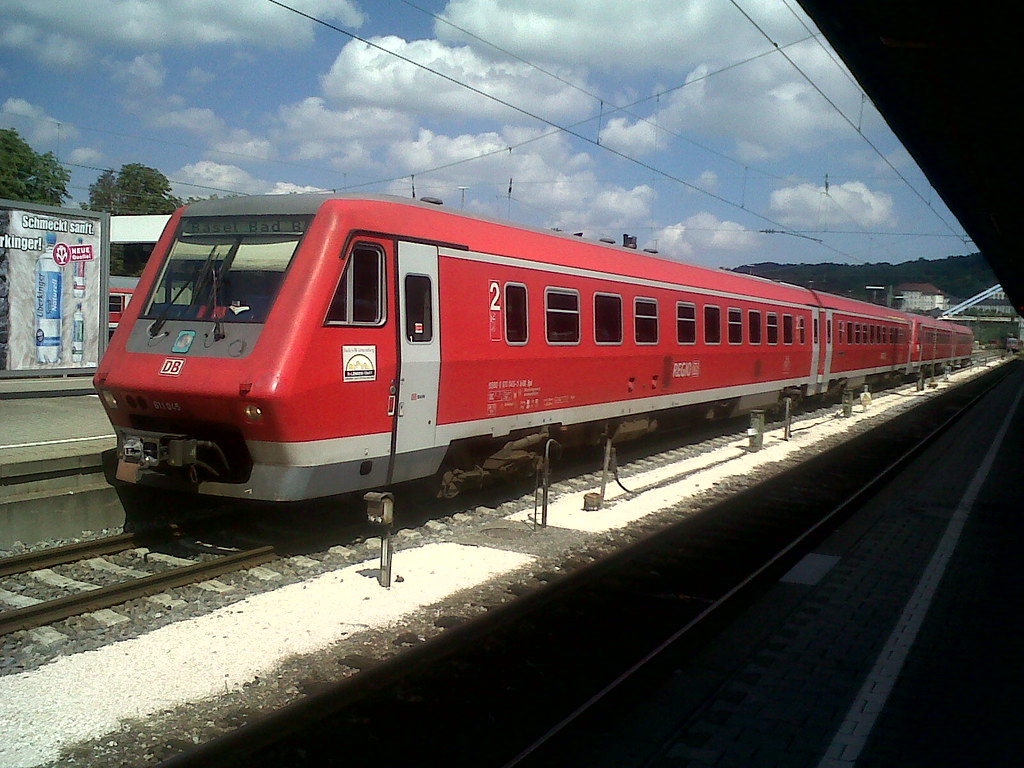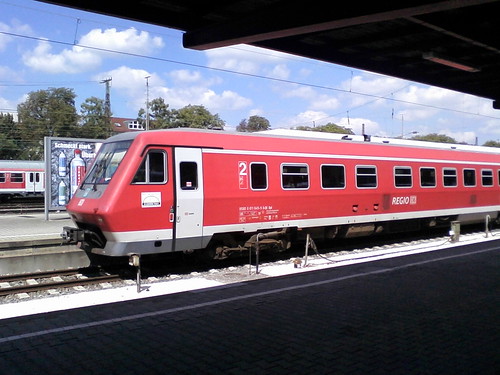DB Class 610
The 610 series refers to two -part diesel railcar with tilting technology, Deutsche Bahn, which were procured by the German Federal Railways and are known in Germany as the Pendolino.
The German Federal Railroad ( DB) ordered with this series after the prototype of the DB Class 614 railcars for the first time again with active tilting technology. There were 1988 and 1990 with 10 pieces total 20 of these two-piece railcar of the 610 series ordered in two series, which were delivered in 1992. The double motor cars were the car numbers 610 001 / 501-610020 / 520, the rear railcar half carries increased by 500 order number.
History
The railcars came in 1992 in the service and proven in use. In 2000, they had to be shut down by order of the Federal Railway Authority for a year because cracks on the suspension of the anti-rolling device occurred. After the rehabilitation of the affected components, the trains have been used successfully from 2001 onwards. In May 2007, ie 15 years after operation recording, the 610 fleet has a total of 70 million miles. From the year 2014, the 610 series is set in the DB out of service. Individual railcars continue to be used by the DB subsidiary Arriva CZ in the Czech Republic.
Development
The German Federal Railroad was prompted by a gradual decline in passengers in the Franconian regional services, to initiate remedial measures to enhance the attractiveness of regional traffic. As the existing track systems did not allow for higher speeds and an expansion of this same financial framework would have blown up, intensified to the efforts to develop a tipping mass transit railcars. The DB commissioned this MAN as the lead for the car structural part (together with DUEWAG and MBB), Siemens as consortium leader for the electrical part (together with ABB and AEG). The bogies and tilting technology, Fiat supplied who built since the 60's under the brand name Pendolino in large numbers Railcars with tilting technology.
Carbody
The superstructure were welded together from aluminum extruded sections and designed to be self -supporting. The car body be hung swinging freely at two bogies.
Initially turquoise / light gray paint was in the years 1997-2001 replaced by a traffic red.
Tilting
Purpose of tilting technology is to increase the travel speed on winding roads. By using the tilting system lateral acceleration is reduced in the vehicle body during cornering. Thus, a curve can be faster than driving without tilting while the maximum lateral acceleration are adhered to in the car body.
Fiat built into the car gyroscopes ( gyros ), with which hydraulic cylinders are controlled. The angle of the swinging freely suspended carbody is glistening arch dependent maximum of 8 °.
Drive
The 610 series has two water-cooled MTU diesel engines with a power output of 485 kW of twelve cylinders. These diesel engines drive three-phase synchronous generators. This unit is used as a power plant, and with its current three -phase AC traction motors are connected via a rectifier and a GTO PWM inverter driven. These transmit their torque on a propeller shaft to the inner axis of three bogies. The fourth bogie is not driven.
Other technical equipment
The two railcars halves are kurzgekuppelt each other and have at their faces automatic Scharfenberg couplers. The vehicles are equipped with point-like train control and speed control tilt technology, which is still working with induction coils in the track and is not compatible with the beacons in use today. From the front cab of up to four coupled together railcars can be controlled in multiple traction.
Passenger compartments
The passenger compartment consists of four large rooms, a thing of the 1st class, 2nd class of the other. A railcar is continuously passable. The 136 seats are upholstered installed both as seating (vis -à- vis) as well as in aircraft assembly. In a large room is equipped with a folding seat, multi-purpose compartment. The employed in regional traffic for the first time vacuum toilet found its place in the middle of the dual carriage.
Use
With the series 610 began at the former German Federal Railways, the use of wing trains coupled together begin at a station has to be divided and then navigate to several target stations. On the return journey the individual train parts are reunited to form a train. This principle was first introduced with the commissioning of the 610 series from Nuremberg to Hof and Bayreuth, later also to Neustadt an der Waldnaab, pastures, Schwandorf and Regensburg. Divided and united are the trains in Hersbruck (right Pegnitz ), Neukirchen bei Sulzbach- Rosenberg and Pegnitz. The trains ran as a regional express train, and later as Regional Express.
The 610 series was located from 1992 to 2011 in the depot Nuernberg West, today it is stationed in the depot yard.
- Regensburg Hbf - Schwandorf -Weiden ( Oberpf ) Marktredwitz -Hof Hbf
- Nürnberg Hbf - Hersbruck (right Pegnitz ) ( Zugflügelung ) Neukirchen ( in Sulzbach -Rosenberg ) Amberg- Schwandorf / Neuhaus ( Pegnitz ) Pegnitz ( Zugflügelung ) Creußen -Bayreuth Hbf / Kirchenlaibach - Marktredwitz ( - Cheb)
- Nürnberg Hbf - Hersbruck (right Pegnitz ) Neukirchen ( in Sulzbach -Rosenberg ) ( Zugflügelung ) Vilseck -Weiden ( Oberpf ) -Neustadt ( Waldnaab ) / Amberg - Sulzbach -Rosenberg - Schwandorf ( Regensburg Hbf)
The timetable change in December 2012, lost the 610 series a large part of their performance. Most RE inserts were transferred to the 612 series. Today, only a few RE trains between Furth and Nuremberg, between Nuremberg and Neustadt an der Waldnaab and between Hof and Regensburg be driven with the 610 series. In addition, driven by its regional trains between Nuremberg and Schwandorf and between Bayreuth and Pegnitz. Overall, only 8 of the 20 railcars are needed.
The German railway plans to take the 610 series the timetable change in December 2014 from the operation and turn off completely. Two railcars were already parked temporarily in the DB - arrest management in Hamm. The DB subsidiary Arriva CZ 610 has now taken over the railcar 017 and 610 018. The company plans to use it in regional transport in the Czech Republic. 610 018 was transferred already to the Czech Republic.
Successor
Originally more railcars in this series were planned with the label 610.1/610.6. But railcars were desired from completely German production of the DB, this plan was discarded in favor of the offer for tilting railcar of the later series 611 of Adtranz. The tilting railcar of Adtranz may not bear the protected from tilting system manufacturer Fiat Ferroviavon brand name Pendolino, because the series is 611 equipped with a newly developed electric (instead of used in the 610 series hydraulic ) tilting system of the then manufacturer Adtranz. Because shortly after the completion of the new railcars of Class 611 encountered major problems with temporary withdrawal of approval, the order was limited to 50 vehicles. The Series 611 was followed by the also by Adtranz vehicles (later Bombardier ) produced the series 612 (so-called "Regio - Swinger " ), which are also equipped with a failure-prone electrical tilt technology.










